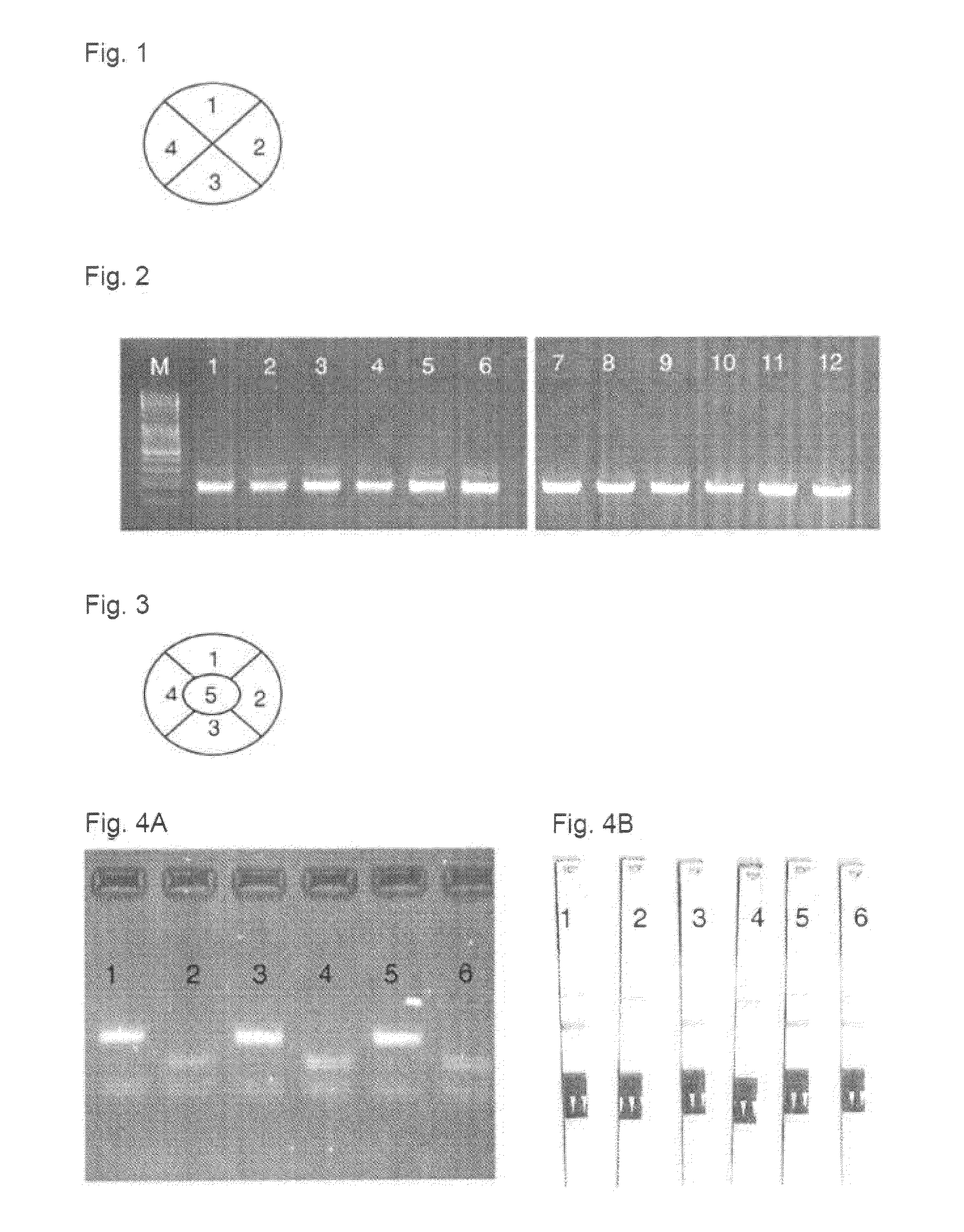Method, device and test kit for molecular-biological reactions
- Summary
- Abstract
- Description
- Claims
- Application Information
AI Technical Summary
Benefits of technology
Problems solved by technology
Method used
Image
Examples
exemplary embodiment 1
Preparation of a Compartmentalized Storage-Stable Reaction Batch and Use in a Storage Test for Amplification of a Human-Specific Target Sequence
A. Preparation of a Compartmentalized Storage-Stable Reaction Batch
[0045]Polyethylene filter disks were used as the porous support.
[0046]The following components were added onto different zones of the filter disk (FIG. 1):
[0047]FIG. 1 shows a filter disk with different zones and PCR materials.[0048]1 Ligand-modified Hot Start Taq DNA Polymerase stabilized with 10% sorbitol and 3.75% FCS in the final batch[0049]2 dNTPs[0050]3 Primer (sense)[0051]4 Primer (antisense)
[0052]The components were applied in an amount corresponding to a 100-μL PCR batch.
[0053]The solutions were applied on the filter disk and dried for approximately 2 hours under physiological temperature conditions (37° C.). After completion of drying, the filter disks were transferred into a 2 mL screw top tube, securely sealed with a cap and stored at room temperature for 3 months...
exemplary embodiment 2
[0060]Preparation of a Compartmentalized Storage-Stable Reaction Batch and Use in a Storage Test for Amplification and Hybridization of a Salmonella enterica—Specific Target Sequence
[0061]The compartmentalized reagents were prepared for performing a probe-based LFA assay. During performance of the assay, it is essential that the FITC-labeled probe and the biotin-labeled primer do not form any dimerization products before the reaction. According to the invention, the compartmentalized application of the individual reaction components is intended to prevent an irregular start to the reaction and in turn to prevent the occurrence of false-positive results.
A. Preparation of a Compartmentalized Storage-Stable Reaction Batch
[0062]Polyethylene filter disks were used as the porous support.
[0063]The following components were added onto different zones of the filter disk (FIG. 3):
[0064]FIG. 3 shows the overhead view of a filter disk. Compartmentalization of storage-stable components for a pro...
exemplary embodiment 3
[0081]Preparation of a Compartmentalized Storage-Stable Reaction Batch and Use Thereof for One-Step cDNA Synthesis and Amplification of an Influenza A Virus.
A. Preparation of a Compartmentalized Storage-Stable Reaction Batch
[0082]Polyethylene filter disks were used as the porous support.
[0083]The following components were added onto different zones of the filter disk (FIG. 5):
[0084]FIG. 5 shows the overhead view of a filter disk. Compartmentalization of storage-stable components for a one-step PCR.
1. FITC-labeled probe
2. Primer 1, unlabeled
3. Primer 2, biotin-labeled
4. Affinityscript enzyme mix for one-step RT-PCR (stabilized if necessary)
5. Furthermore, buffer containing dNTPs was dried on the bottom of the test tube (Herculase® II RT-PCR 2× Mastermix, Agilent)
[0085]The chemicals were applied in an amount corresponding to a 100-μL batch. The solutions were applied on the filter disk or on the bottom of a 2-ml screw top tube, sealed with a screw cap and dried for approximately 2 hou...
PUM
 Login to View More
Login to View More Abstract
Description
Claims
Application Information
 Login to View More
Login to View More - R&D
- Intellectual Property
- Life Sciences
- Materials
- Tech Scout
- Unparalleled Data Quality
- Higher Quality Content
- 60% Fewer Hallucinations
Browse by: Latest US Patents, China's latest patents, Technical Efficacy Thesaurus, Application Domain, Technology Topic, Popular Technical Reports.
© 2025 PatSnap. All rights reserved.Legal|Privacy policy|Modern Slavery Act Transparency Statement|Sitemap|About US| Contact US: help@patsnap.com


